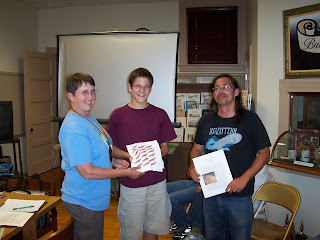Donald A. Windsor
As indicated in my posting of 23 July 2011 on this blog, I mentioned needing photos of Black ash samaras (the winged fruit carrying the seed).
On Thursday morning 28 July 2011, Anne Altshuler, Joyce Post, and I went to the Adams Farm, a Rogers Center property, in the Town of Sherburne. I had located some Black ash growing there on 25 May 2009.
We quickly found the Black Ash grove in a swamp standing on a year-around seep, on the southwestern side of the 4th pond (the south-easternmost pond). Several dozen Black Ash trees grow here. Most are small enough to grasp with one hand and shake.
The one in the photo below required two hands.
We were finding no trees with samaras. Spice bushes was so thick that we could smell them when walking among them. The spice bushes had berry-like fruit.
But then the sharp-eyed Joyce Post spotted a large Black Ash. The photo below shows the trunk of the tree, which measured 36.5 inches circumference at my breast height, for a diameter of 11.6 inches. This was the largest Black Ash we could find in this grove.
The photo below shows how the samaras appeared under it, on the mud floor of the swamp, among the skunk cabbage.
I picked up a representative sample of about 30 samaras. The photo below shows them in the top 2 rows. The right column shows White Ash samaras for comparison; they were picked up under a tree on East Main Street in Norwich. The white Ash is our most common ash locally. In this swamp, they were growing along side the Black Ash, but we did not find any of their samaras.
In the closer view below, the Black Ash samaras are on top.
Note that the seed portion of the Black Ash samaras are so flat that they are almost undetectable. Whereas the seed portion of the White Ash samaras are noticeable, palpable swellings. Note also the wider and slightly twisted samaras of the Black Ash.
Anyone finding Black Ash any where in Chenango County is encouraged to notify me.
==============================
















